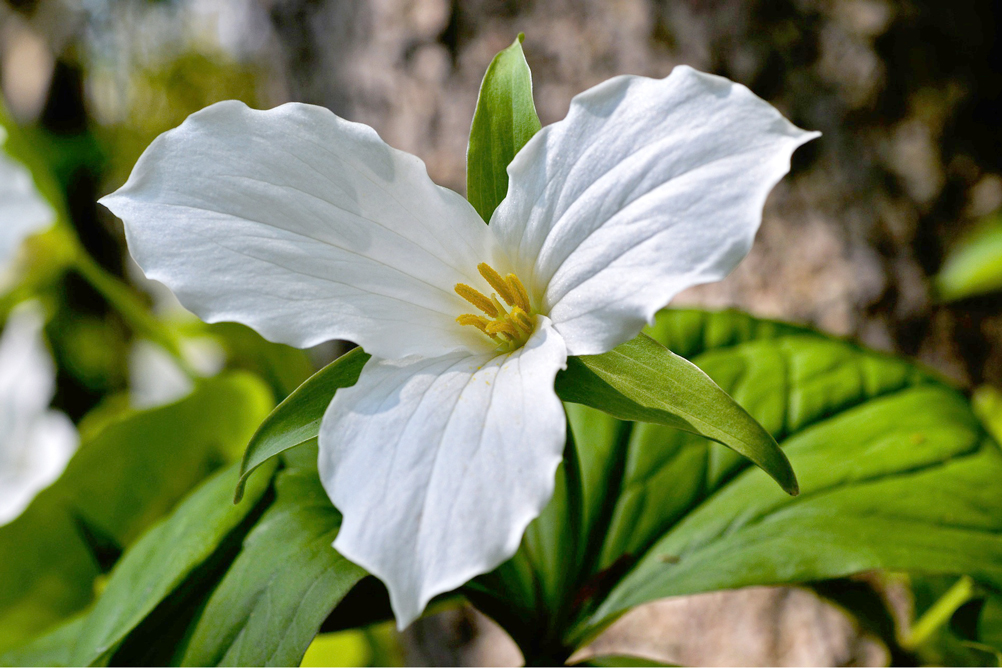Ohio’s native wildflowers: what to look for TOP 10

By STEPHANIE HUGHES
Ohio Certified Volunteer Naturalist
I love Ohio! It is such a beautiful state, and with the change of seasons, it offers a wide array of native wildflowers that invite spring and wow us with color, scents and sights that are truly amazing.
They are also vital for our early pollinators. Though there are possibly more than 100, I have picked my top 10 to investigate and invite you to look for this spring.
Take time to take a hike with your family and visit our local nature centers and parks.
Here is my top 10 list:
Bloodroot is a perennial also called bloodwort, redroot or tetterwort. Leaves are variable in shape. It grows 8- to 20-inches tall, with a large basal leaf up to 5 inches across, with five to nine lobes. They are pollinated by bees and flies. The juice is red and poisonous. This plant is used by people for a red dye, and it is on the endangered lists of some states.
The blue-eyed violet is stemless and also called meadow violet, purple violet, or wood violet. It is a nuisance in lawns. It has been used for food and medicine, having three times more vitamin C than oranges. It blooms for six weeks in midspring. Game birds and small mammals depend on the capsules. Turkeys browse on the leaves and roots.
Coltsfoot is a naturalized plant brought by settlers. The dandelion-like flowers are seen in ditches, along roads, and disturbed areas. These perennials grow from seeds and rhizomes to form dense colonies. This medicinal plant was used for sore throats and coughs. It is a member of the daisy family, and sprouts like asparagus.
Jack-in-the-Pulpit also known as bog onion, brown dragon, Indian turnip, American Wake Robin, and wild turnip. It is a 12- to 26-inch tall perennial that develops from a corm. Flowers are green to green-yellow, with purple stripes, brown stripes or no stripes. Flies are attracted to the smell for pollination. Fruit is shiny green and ripen to bright red. This plant is poisonous.
The large-flowered Trillium is 8- to 16-inches tall and spreads by underground rhizomes. There are three green or reddish sepals, with petals of white, yellow, green, pink or purple. Blooms age to pink for three weeks. Picking any part of the plant and/or flower can kill it, so this plant is threatened and endangered.
May Apples – we have all seen the spring “umbrellas” – are 12- to 18-inch-tall perennials with leaves that have five to nine lobes that shelter waxy white blossoms. Their pleasant fragrance attracts bees and ants. It is poisonous and bitter. The ripened fruit is eaten by turtles, opossums, raccoons and skunks.
Sharp-lobed hepatica is a 3- to 6-inch perennial. In spring, the 6-inch petioles emerge with leaves of three lobes. They are green, brown-green or reddish brown with pointed tips. They bloom two to three weeks in colonies spread by reseeding. This plant is poisonous.
Skunk cabbage heats up the air around its flowers by as much as 30 degrees Fahrenheit to bloom. Yes, the plant stinks when crushed. Flowers are turban shaped in shades of wine or maroon mottled with patches of yellow green. The large 26-by-26-inch bright green leaves are toxic with an inflammatory reaction if touched.
Spring Beauty is known by the beautiful clouds of tiny flowers seen in ditches and lawns each spring. Flowers have white to pink petals with pink stripes. They have a pleasant scent. They bloom for one or two months and are pollinated by bees and flies.
Trout lily is also known as adder’s tongue, yellow dogtooth violet and yellow trout lily. It grows from edible bulbs and has edible leaves, though it is an emetic (vomiting agent). It is pollinated by ants. It takes seven years to mature. They open in the morning, curving backward for bee access. They are endangered by invasive Garlic Mustard.
 43
43
